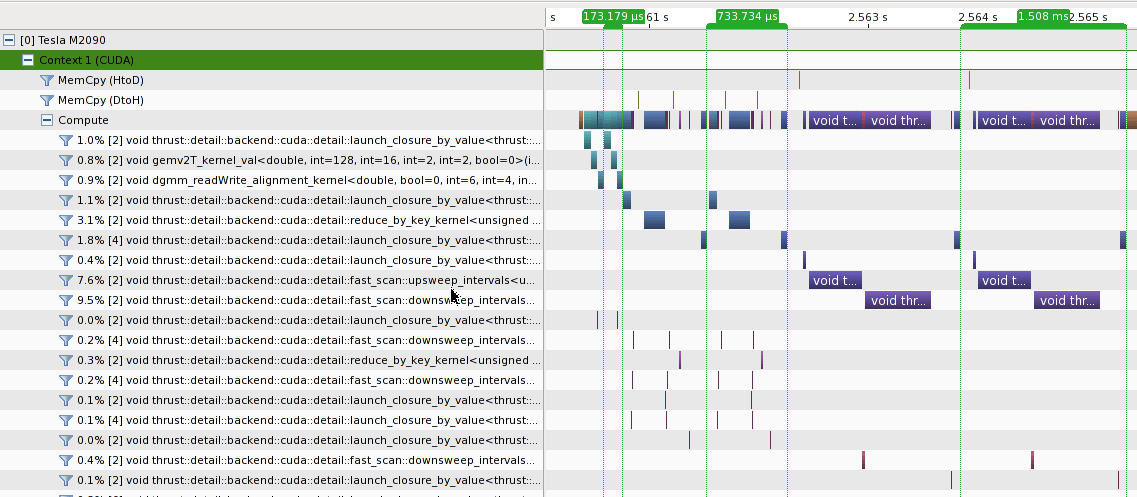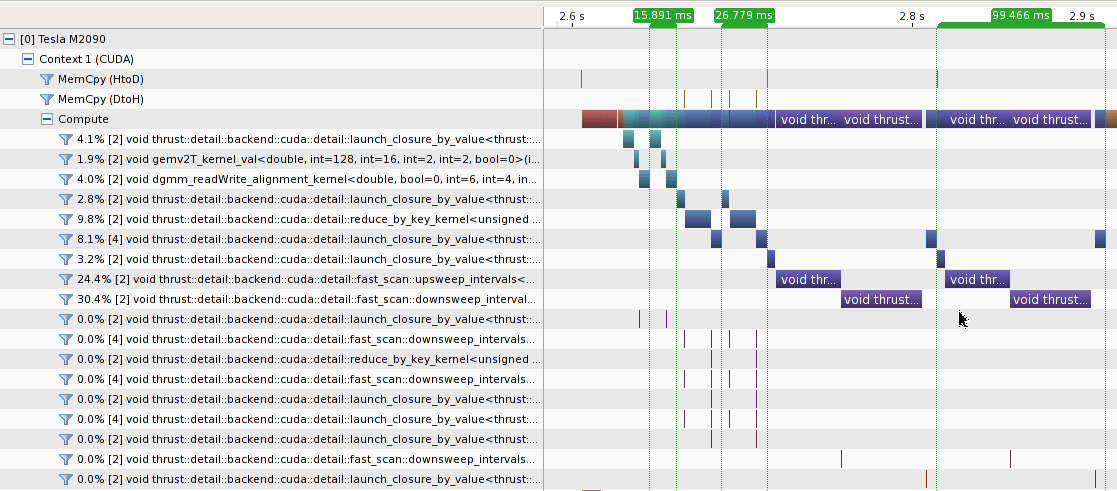Как нормализовать матричные столбцы в CUDA с максимальной производительностью?
Как эффективно нормализовать матричные столбцы в CUDA?
Моя матрица хранится в столбце-мажоре, и типичный размер - 2000x200.
Операция может быть представлена в следующем коде Matlab.
A = rand(2000,200);
A = exp(A);
A = A./repmat(sum(A,1), [size(A,1) 1]);
Может ли это быть эффективно сделано с помощью Thrust, cuBLAS и / или cuNPP?
Быстрая реализация, включающая 4 ядра, показана ниже.
Интересно, можно ли это сделать в 1 или 2 ядрах для повышения производительности, особенно для шага суммирования столбцов, реализованного cublasDgemv().
#include <cuda.h>
#include <curand.h>
#include <cublas_v2.h>
#include <thrust/device_vector.h>
#include <thrust/device_ptr.h>
#include <thrust/transform.h>
#include <thrust/iterator/constant_iterator.h>
#include <math.h>
struct Exp
{
__host__ __device__ void operator()(double& x)
{
x = exp(x);
}
};
struct Inv
{
__host__ __device__ void operator()(double& x)
{
x = (double) 1.0 / x;
}
};
int main()
{
cudaDeviceSetCacheConfig(cudaFuncCachePreferShared);
cublasHandle_t hd;
curandGenerator_t rng;
cublasCreate(&hd);
curandCreateGenerator(&rng, CURAND_RNG_PSEUDO_DEFAULT);
const size_t m = 2000, n = 200;
const double c1 = 1.0;
const double c0 = 0.0;
thrust::device_vector<double> A(m * n);
thrust::device_vector<double> sum(1 * n);
thrust::device_vector<double> one(m * n, 1.0);
double* pA = thrust::raw_pointer_cast(&A[0]);
double* pSum = thrust::raw_pointer_cast(&sum[0]);
double* pOne = thrust::raw_pointer_cast(&one[0]);
for (int i = 0; i < 100; i++)
{
curandGenerateUniformDouble(rng, pA, A.size());
thrust::for_each(A.begin(), A.end(), Exp());
cublasDgemv(hd, CUBLAS_OP_T, m, n,
&c1, pA, m, pOne, 1, &c0, pSum, 1);
thrust::for_each(sum.begin(), sum.end(), Inv());
cublasDdgmm(hd, CUBLAS_SIDE_RIGHT, m, n, pA, m, pSum, 1, pA, m);
}
curandDestroyGenerator(rng);
cublasDestroy(hd);
return 0;
}
3 ответа
Я сравнил производительность 3 подходов на M2090 с CUDA 5.0.
- [173.179 us] реализация cublas, как показано в вопросе
- [733.734 us] Чистая реализация Thrust с
thrust::reduce_by_keyот @talonmies - [1,508 мс] чистая реализация Thrust с
thrust::inclusive_scan_by_key

Видно, что
- Cublas имеет самую высокую производительность в этом случае;
- и то и другое
thrust::reduce_by_key&thrust::inclusive_scan_by_keyзапускать несколько ядер, что приводит к дополнительным издержкам; thrust::inclusive_scan_by_keyзаписывает намного больше данных в DRAM по сравнению сthrust::reduce_by_key, что может быть одной из причин увеличения времени работы ядра;- Основное различие в производительности между кубами и упорным подходом заключается в суммировании столбцов матрицы. тяга медленнее, возможно, потому что
thrust::reduce_by_keyпредназначен для сокращения отрезков с длиной варианта, ноcublas_gemv()может применяться только к сегментам фиксированной длины (строка / столбец).
Когда матрица A достаточно велика, чтобы игнорировать издержки запуска ядра, подход cublas по-прежнему работает лучше всего. Результат профилирования на A_{20 000 x 2000} показан следующим образом.

Фьюзинг первый for_each работа с cublasSgemv вызов как указано @talonmies может еще больше улучшить производительность, но я думаю, что ядро, написанное от руки, следует использовать вместо thrust::reduce_by_key,
Код для 3 подходов показан следующим образом.
#include <cuda.h>
#include <curand.h>
#include <cublas_v2.h>
#include <thrust/device_vector.h>
#include <thrust/device_ptr.h>
#include <thrust/transform.h>
#include <thrust/reduce.h>
#include <thrust/scan.h>
#include <thrust/iterator/counting_iterator.h>
#include <thrust/iterator/transform_iterator.h>
#include <thrust/iterator/discard_iterator.h>
#include <thrust/iterator/permutation_iterator.h>
#include <math.h>
struct Exp: public thrust::unary_function<double, double>
{
__host__ __device__ double operator()(double x)
{
return exp(x);
}
};
struct Inv: public thrust::unary_function<double, double>
{
__host__ __device__ double operator()(double x)
{
return (double) 1.0 / x;
}
};
template<typename T>
struct MulC: public thrust::unary_function<T, T>
{
T C;
__host__ __device__ MulC(T c) :
C(c)
{
}
__host__ __device__ T operator()(T x)
{
return x * C;
}
};
template<typename T>
struct line2col: public thrust::unary_function<T, T>
{
T C;
__host__ __device__ line2col(T C) :
C(C)
{
}
__host__ __device__ T operator()(T i)
{
return i / C;
}
};
int main()
{
cudaDeviceSetCacheConfig(cudaFuncCachePreferShared);
cublasHandle_t hd;
curandGenerator_t rng;
cublasCreate(&hd);
curandCreateGenerator(&rng, CURAND_RNG_PSEUDO_DEFAULT);
const size_t m = 2000, n = 200;
const double c1 = 1.0;
const double c0 = 0.0;
thrust::device_vector<double> A(m * n);
thrust::device_vector<double> B(m * n);
thrust::device_vector<double> C(m * n);
thrust::device_vector<double> sum1(1 * n);
thrust::device_vector<double> sum2(1 * n);
thrust::device_vector<double> one(m * n, 1);
double* pA = thrust::raw_pointer_cast(&A[0]);
double* pB = thrust::raw_pointer_cast(&B[0]);
double* pSum1 = thrust::raw_pointer_cast(&sum1[0]);
double* pSum2 = thrust::raw_pointer_cast(&sum2[0]);
double* pOne = thrust::raw_pointer_cast(&one[0]);
curandGenerateUniformDouble(rng, pA, A.size());
const int count = 2;
for (int i = 0; i < count; i++)
{
thrust::transform(A.begin(), A.end(), B.begin(), Exp());
cublasDgemv(hd, CUBLAS_OP_T, m, n, &c1, pB, m, pOne, 1, &c0, pSum1, 1);
thrust::transform(sum1.begin(), sum1.end(), sum1.begin(), Inv());
cublasDdgmm(hd, CUBLAS_SIDE_RIGHT, m, n, pB, m, pSum2, 1, pB, m);
}
for (int i = 0; i < count; i++)
{
thrust::reduce_by_key(
thrust::make_transform_iterator(thrust::make_counting_iterator(0), line2col<int>(m)),
thrust::make_transform_iterator(thrust::make_counting_iterator(0), line2col<int>(m)) + A.size(),
thrust::make_transform_iterator(A.begin(), Exp()),
thrust::make_discard_iterator(),
sum2.begin());
thrust::transform(
A.begin(), A.end(),
thrust::make_permutation_iterator(
sum2.begin(),
thrust::make_transform_iterator(thrust::make_counting_iterator(0), line2col<int>(m))),
C.begin(),
thrust::divides<double>());
}
for (int i = 0; i < count; i++)
{
thrust::inclusive_scan_by_key(
thrust::make_transform_iterator(thrust::make_counting_iterator(0), line2col<int>(m)),
thrust::make_transform_iterator(thrust::make_counting_iterator(0), line2col<int>(m)) + A.size(),
thrust::make_transform_iterator(A.begin(), Exp()),
C.begin());
thrust::copy(
thrust::make_permutation_iterator(
C.begin() + m - 1,
thrust::make_transform_iterator(thrust::make_counting_iterator(0), MulC<int>(m))),
thrust::make_permutation_iterator(
C.begin() + m - 1,
thrust::make_transform_iterator(thrust::make_counting_iterator(0), MulC<int>(m))) + n,
sum2.begin());
thrust::transform(
A.begin(), A.end(),
thrust::make_permutation_iterator(
sum2.begin(),
thrust::make_transform_iterator(thrust::make_counting_iterator(0), line2col<int>(m))),
C.begin(),
thrust::divides<double>());
}
curandDestroyGenerator(rng);
cublasDestroy(hd);
return 0;
}
Вы должны быть в состоянии слить первый for_each работа с cublasSgemv позвонить в один reduce_by_key вызов. Если вы определяете / переопределяете функторы как:
struct Accessor : public thrust::unary_function<int,int>
{
int lda;
__host__ __device__ Accessor(int _lda) : lda(_lda) {};
__host__ __device__ int operator()(const int& idx)
{
return idx/lda;
}
};
struct Exp : public thrust::unary_function<double,double>
{
__host__ __device__ double operator()(const double& x)
{
return exp(x);
}
};
struct Inv : public thrust::unary_function<double,double>
{
__host__ __device__ double operator()(const double& x)
{
return double(1.0) / x;
}
};
Затем вы можете рассчитать нормированный выход как
Accessor columns(m);
thrust::reduce_by_key(
thrust::make_transform_iterator(thrust::make_counting_iterator(int(0)), columns),
thrust::make_transform_iterator(thrust::make_counting_iterator(int(m*n)), columns),
thrust::make_transform_iterator(A.begin(), Exp()),
thrust::make_discard_iterator(),
sum.begin());
thrust::for_each(sum.begin(), sum.end(), Inv());
cublasDdgmm(hd, CUBLAS_SIDE_RIGHT, m, n, pA, m, pSum, 1, pA, m);
[отказ от ответственности: весь код написан в браузере и не проверен, используйте на свой страх и риск]
Помимо уменьшения количества вызовов ядра, использование причудливых итераторов устраняет необходимость в большой единичной матрице, которая должна уменьшить объем памяти и общее количество транзакций памяти для выполнения операций суммирования и возведения в степень.
Вы можете использовать ArrayFire следующим образом
array A = randu(2000, 2000);
A = exp(A);
A /= tile(sum(A, 0), A.dims(0), 1);
Вы могли бы сделать это и в толчке. Но если вы собираетесь работать с матрицами (в отличие от простых векторов), вам придется делать это в цикле for, который не будет столь эффективным.
ОТКАЗ ОТ ОТВЕТСТВЕННОСТИ Я разработчик в Accelereyes, работающий над arrayfire.
РЕДАКТИРОВАТЬ Я работаю над созданием новых ориентиров в соответствии с просьбой.
РЕДАКТИРОВАТЬ Мы нашли ошибки производительности для exp в нашем коде из-за этого теста. Мы рассматриваем и исправляем это.